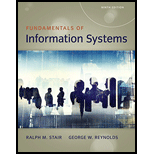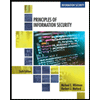
Fundamentals of Information Systems
9th Edition
ISBN: 9781337097536
Author: Ralph Stair, George Reynolds
Publisher: Cengage Learning
expand_more
expand_more
format_list_bulleted
Question
Chapter 9, Problem 11SAT
Program Plan Intro
Choose the correct option to fill in the blank.
Expert Solution & Answer
Want to see the full answer?
Check out a sample textbook solution
Students have asked these similar questions
What is cloud computing and why do we use it? Give one of your friends with your answer.
What are triggers and how do you invoke them on demand? Give one reference with your answer.
Discuss with appropriate examples the types of relationships in a database. Give one reference with your answer.
Chapter 9 Solutions
Fundamentals of Information Systems
Ch. 9 - Prob. 1LOCh. 9 - Prob. 2LOCh. 9 - Prob. 3LOCh. 9 - Prob. 4LOCh. 9 - Prob. 5LOCh. 9 - Prob. 1.1RQCh. 9 - Prob. 1.2RQCh. 9 - Prob. 1.1CTQCh. 9 - Prob. 1.2CTQCh. 9 - Prob. 2.1RQ
Ch. 9 - Prob. 2.2RQCh. 9 - Prob. 2.1CTQCh. 9 - Prob. 2.2CTQCh. 9 - Prob. 1SATCh. 9 - Prob. 2SATCh. 9 - Prob. 3SATCh. 9 - Prob. 4SATCh. 9 - Prob. 5SATCh. 9 - Prob. 6SATCh. 9 - Prob. 7SATCh. 9 - Prob. 8SATCh. 9 - Prob. 9SATCh. 9 - Prob. 10SATCh. 9 - Prob. 11SATCh. 9 - Prob. 12SATCh. 9 - Prob. 13SATCh. 9 - Prob. 14SATCh. 9 - Prob. 1RQCh. 9 - Prob. 2RQCh. 9 - Prob. 3RQCh. 9 - Prob. 4RQCh. 9 - Prob. 5RQCh. 9 - Prob. 6RQCh. 9 - Prob. 7RQCh. 9 - Prob. 8RQCh. 9 - Prob. 9RQCh. 9 - Prob. 10RQCh. 9 - Prob. 11RQCh. 9 - Prob. 12RQCh. 9 - Prob. 13RQCh. 9 - Prob. 14RQCh. 9 - Prob. 15RQCh. 9 - Prob. 16RQCh. 9 - Prob. 1DQCh. 9 - Prob. 2DQCh. 9 - Prob. 3DQCh. 9 - Prob. 4DQCh. 9 - Prob. 5DQCh. 9 - Prob. 6DQCh. 9 - Prob. 7DQCh. 9 - Prob. 1PSECh. 9 - Prob. 2PSECh. 9 - Prob. 1WECh. 9 - Prob. 2WECh. 9 - Prob. 3WECh. 9 - Prob. 1CECh. 9 - Prob. 2CECh. 9 - Prob. 3CECh. 9 - Prob. 1.1CSCh. 9 - Prob. 1.2CSCh. 9 - Prob. 1.3CSCh. 9 - Prob. 2.1CSCh. 9 - Prob. 2.2CSCh. 9 - Prob. 2.3CS
Knowledge Booster
Similar questions
- Determine the velocity error constant (k,) for the system shown. + R(s)- K G(s) where: K=1.6 A(s+B) G(s) = as²+bs C(s) where: A 14, B =3, a =6. and b =10arrow_forward• Solve the problem (pls refer to the inserted image)arrow_forwardWrite .php file that saves car booking and displays feedback. There are 2 buttons, which are <Book it> <Select a date>. <Select a date> button gets an input from the user, start date and an end date. Book it button can be pressed only if the start date and ending date are chosen by the user. If successful, it books cars for specific dates, with bookings saved. Booking should be in the .json file which contains all the bookings, and have the following information: Start Date. End Date. User Email. Car ID. If the car is already booked for the selected period, a failure message should be displayed, along with a button to return to the homepage. In the booking.json file, if the Car ID and start date and end date matches, it fails Use AJAX: Save bookings and display feedback without page refresh, using a custom modal (not alert).arrow_forward
- Write .php file with the html that saves car booking and displays feedback. Booking should be in the .json file which contains all the bookings, and have the following information: Start Date. End Date. User Email. Car ID. There are 2 buttons, which are <Book it> <Select a date> Book it button can be pressed only if the start date and ending date are chosen by the user. If successful, book cars for specific dates, with bookings saved. If the car is already booked for the selected period, a failure message should be displayed, along with a button to return to the homepage. Use AJAX: Save bookings and display feedback without page refresh, using a custom modal (not alert). And then add an additional feature that only free dates are selectable (e.g., calendar view).arrow_forward• Solve the problem (pls refer to the inserted image) and create line graph.arrow_forwardwho started the world wide webarrow_forward
- Question No 1: (Topic: Systems for collaboration and social business The information systems function in business) How does Porter's competitive forces model help companies develop competitive strategies using information systems? • List and describe four competitive strategies enabled by information systems that firms can pursue. • Describe how information systems can support each of these competitive strategies and give examples.arrow_forwardData communıcatıon digital data is transmitted via analog ASK and PSK are used together to increase the number of bits transmitted a)For m=8,suggest a solution and define signal elements , and then draw signals for the following sent data data = 0 1 0 1 1 0 0 0 1 0 1 1arrow_forwardDatacommunicationData = 1 1 0 0 1 0 0 1 0 1 1 1 1 0 0a) how many bıts can be detected and corrected by this coding why prove?b)what wıll be the decision of the reciever if it recieve the following codewords why?arrow_forward
- pattern recognitionPCA algor'thmarrow_forwardConsider the following program: LOAD AC, IMMEDIATE(30) ADD AC, REGISTER(R1) STORE AC, MEMORY(20) Given that the value of R1 is 50, determine the value stored at memory address 20 after the program is executed. Provide an explanation to support your answer.arrow_forwardPattern RecognitonDecision Tree please write the steps not only last answerarrow_forward
arrow_back_ios
SEE MORE QUESTIONS
arrow_forward_ios
Recommended textbooks for you
 Fundamentals of Information SystemsComputer ScienceISBN:9781337097536Author:Ralph Stair, George ReynoldsPublisher:Cengage Learning
Fundamentals of Information SystemsComputer ScienceISBN:9781337097536Author:Ralph Stair, George ReynoldsPublisher:Cengage Learning Principles of Information Systems (MindTap Course...Computer ScienceISBN:9781305971776Author:Ralph Stair, George ReynoldsPublisher:Cengage Learning
Principles of Information Systems (MindTap Course...Computer ScienceISBN:9781305971776Author:Ralph Stair, George ReynoldsPublisher:Cengage Learning Management Of Information SecurityComputer ScienceISBN:9781337405713Author:WHITMAN, Michael.Publisher:Cengage Learning,
Management Of Information SecurityComputer ScienceISBN:9781337405713Author:WHITMAN, Michael.Publisher:Cengage Learning, Principles of Information Security (MindTap Cours...Computer ScienceISBN:9781337102063Author:Michael E. Whitman, Herbert J. MattordPublisher:Cengage Learning
Principles of Information Security (MindTap Cours...Computer ScienceISBN:9781337102063Author:Michael E. Whitman, Herbert J. MattordPublisher:Cengage Learning Information Technology Project ManagementComputer ScienceISBN:9781337101356Author:Kathy SchwalbePublisher:Cengage Learning
Information Technology Project ManagementComputer ScienceISBN:9781337101356Author:Kathy SchwalbePublisher:Cengage Learning

Fundamentals of Information Systems
Computer Science
ISBN:9781337097536
Author:Ralph Stair, George Reynolds
Publisher:Cengage Learning

Principles of Information Systems (MindTap Course...
Computer Science
ISBN:9781305971776
Author:Ralph Stair, George Reynolds
Publisher:Cengage Learning

Management Of Information Security
Computer Science
ISBN:9781337405713
Author:WHITMAN, Michael.
Publisher:Cengage Learning,

Principles of Information Security (MindTap Cours...
Computer Science
ISBN:9781337102063
Author:Michael E. Whitman, Herbert J. Mattord
Publisher:Cengage Learning

Information Technology Project Management
Computer Science
ISBN:9781337101356
Author:Kathy Schwalbe
Publisher:Cengage Learning